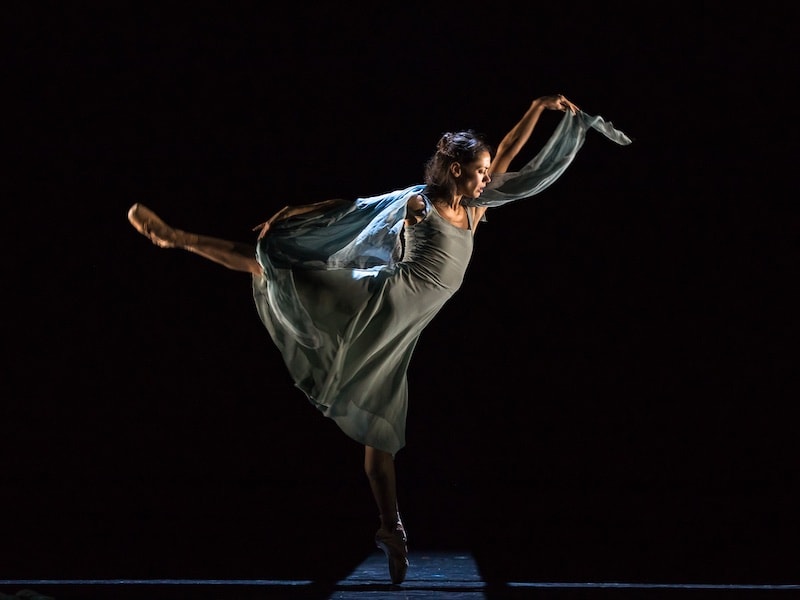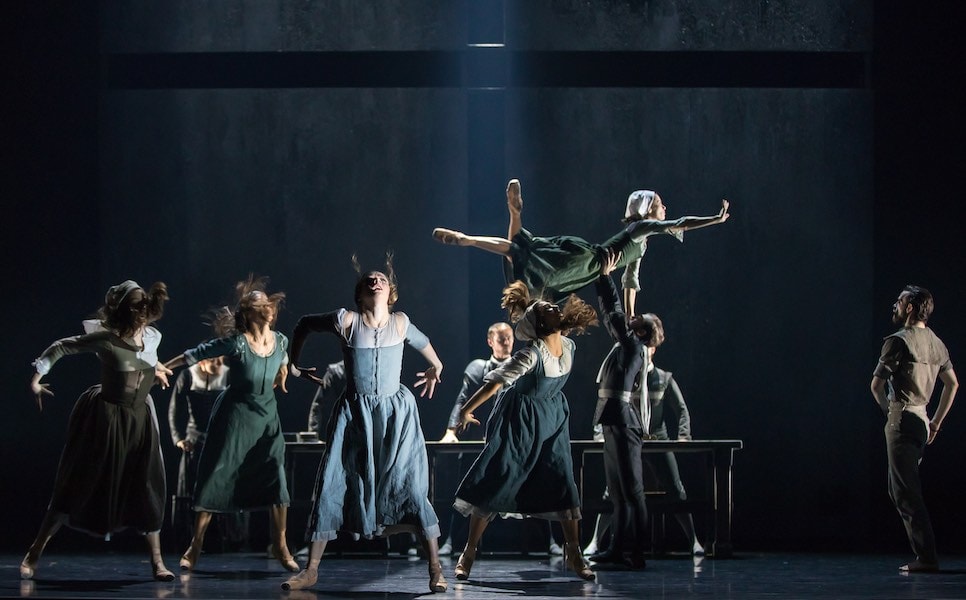By Lisa Troshinsky
The Scottish Ballet, currently at The Kennedy Center, has brilliantly transformed an iconic 1950s drama/tragedy classic into a full-length dance narrative. Anyone who remotely enjoys dance needs to see the Scottish Ballet’s East Coast premiere of The Crucible.
Helen Pickett’s powerful choreography and Peter Salem’s haunting score bring to life the histrionic struggles of Puritan life when childish scapegoating turned into a community massacre.

The story, by Playwright Arthur Miller, is a dramatized and partially fictionalized story of the Salem Witch trials that took place in the Massachusetts Bay Colony during the 1600s. Miller wrote the play as an allegory for McCarthyism when the U.S. government persecuted people accused of communism.
This production ingeniously creates the cryptic world of the Puritans through bold movement, eerie lighting, dramatic music, a minimalistic set, and simple props.
At the start of the ballet, choreographer Pickett uses a girl playing with a small doll’s house to represent the whole of the vulnerable and isolated religious Puritan community whose members are as easily manipulated as are figurines by naughty youth.
The production stars Kayla Maree Tarantolo as the servant and seductress Abigail, who is unsuccessful in breaking up the marriage of Elizabeth and John Proctor, played by Bethany Kingsley Garner and Bruno Micchiardi, respectively. However, her character is eventually responsible for the couple’s downfall.
The illicit seduction scene between young Abigail and John Proctor builds to a fevered pitch, as an almost violent musical crescendo dramatizes their aggressive lovemaking before Proctor pushes her away.
The sparse set is then removed, leaving Tarantolo isolated on stage in the spotlight as she expertly performs a tortured solo, demonstrating Abigail’s outcast role in a strict society where she has no constructive outlet.
Pickett writes in the program, “Abigail is dealing with Post Traumatic Stress Disorder. She has seen her parents slaughtered and she has been taken in by her uncle but what she really wants is to belong.”
The formidable church scenes emphasize the weight of Puritanism that preached a judgmental God, predetermined salvation or damnation, and Original Sin. Groups of dancers mimic the regulated gestures of the priest and dance in systemized unison in a culture where there was no room for error.
However, in the middle of harmonious dancing, a group momentarily breaks out from the mold, the light on them dims, and chaotic writhing movement ensues, only for them to move back into the fold again.
Much of the dancing is classical ballet, especially in the mournful pas de deux (dance for two people) between Elizabeth and John Proctor. However, at times, to demonstrate a more violent or frenzied intensity, the choreography morphs into modern dance gestures, exposing raw emotions and mood changes. In the forest scene, for example, when the teenage girls conjure up spirits, jerky, animalistic movement takes over.
Set and Lighting Designer David Finn makes good use of darkness and shadows when the underbelly of the community rears its vile head.

Although The Crucible is over 60 years old, it is also ripe like a good wine. It can be stored away for some time but when opened it packs a punch.
Composer Salem admits in a program note that The Crucible is not an obvious choice for ballet but believes that makes it more interesting:
“When I was writing the music, I was always referring to the play but we are not ‘doing’ the play but rather are finding the emotional undercurrents of every scene and making clear what is going on at every single moment … it’s about finding the way through the two opposing narratives — one full of violence and brutality and the other represented by the relationship between John Proctor and his wife Elizabeth which is full of love.”
Pickett believes, according to the production’s program notes, that the story throws a challenge down to us at a time when new shadows loom and fear of the unknown and outsiders is on the rise.
Watching the dance, one wonders: Is our society rearing its ugly head?
Running Time: One hour and 45 minutes, with one intermission.
The Crucible — which had its world premiere in August 2019 at the famed Edinburgh International Festival — plays through May 28, 2023, presented by Scottish Ballet performing in the Eisenhower Theater at the Kennedy Center, 2700 F Street NW, Washington, DC. Tickets ($39–$129) are available at the box office, online, or by calling (202) 467-4600 or (800) 444-1324.
Recommended for audiences 12+.
The program for The Crucible is online here.
COVID Safety: Masks are optional in all Kennedy Center spaces for visitors and staff. If you prefer to wear a mask, you are welcome to do so. See Kennedy Center’s complete COVID Safety Plan here.





